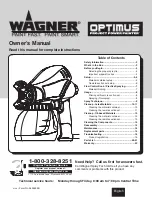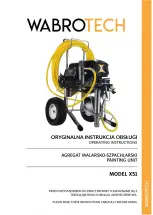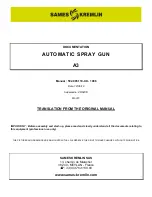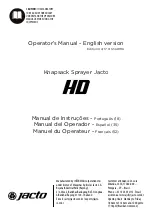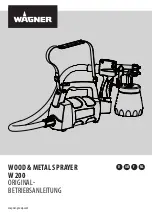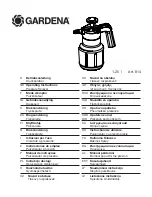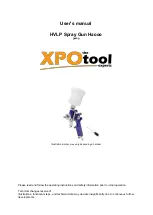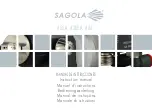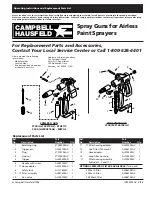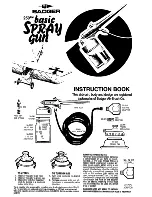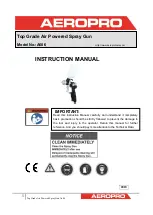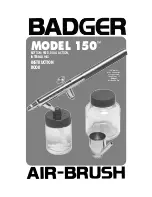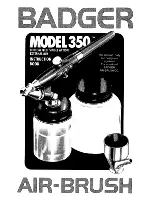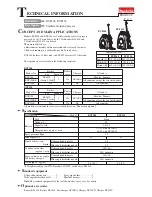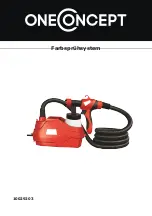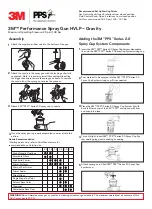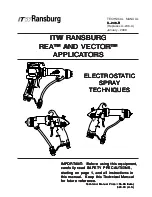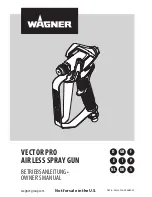
This symbol indicates a hazardous situation, which, if not
not avoided could result in death or serious injury.
HazaRd: InjeCTIOn InjURy
A high pressure stream of paint produced by this equipment
can pierce the skin and underlying tissues, leading to serious
injury and possible amputation.
dO nOT TReaT an InjeCTIOn InjURy aS a SIMPLe
CUT! Injection can lead to amputation. See a physician
immediately.
nOTe TO PHySICIan:
Injection into the skin is a traumatic injury. It is important to treat
the injury surgically as soon as possible. dO nOT delay treatment to
research toxicity. Toxicity is a concern with some coatings injected
directly into the blood stream. Consultation with a plastic surgeon or
reconstructive hand surgeon may be advisable.
PRevenTIOn:
• NEVER aim the gun at any part of the body.
• Do not aim the gun at, or spray any person or animal.
• NEVER allow any part of the body to come in contact with the fluid
stream.
• NEVER put your hand in front of the gun. Wear gloves. Gloves will
not provide protection against an injection injury.
• Keep hands and other body parts away from the discharge. For
example, do not try to stop leaks with any part of the body.
• Always unplug the spray gun before servicing, cleaning tip guard,
changing tips, or leaving unattended.
• Always use the nozzle tip guard. Do not spray without nozzle tip
guard in place.The tip guard provides some protection against
injection injuries but is mainly a warning device. Only use a nozzle
tip specified by Wagner.
HazaRd: eXPLOSIOn OR FIRe
Solvent and paint fumes can explode or ignite, causing
property damage and/or severe injury.
PRevenTIOn:
• Exhaust and fresh air introduction must be provided
to keep the air within the spray area free from accumulation of
flammable vapors.
• Avoid all ignition sources such as static electricity
sparks, open flames, pilot lights, hot objects,
cigarettes, and sparks from connecting and
disconnecting power cords or working light switches.
• Fire extinguishing equipment must be present and in
good working order.
• Follow the material and solvent manufacturer’s safety precautions
and warnings.
• Do not spray flammable or combustable materials near an open
flame or sources of ignition such as cigarettes, motors, and electrical
equipment.
• Know the contents of the paints and solvents being sprayed. Read
all Material Safety Data Sheets (MSDS) and container labels
provided with the paints and solvents. Follow the paint and solvent
manufacturer’s safety instructions.
HazaRd: eXPLOSIOn HazaRd dUe TO
InCOMPaTIBLe MaTeRIaLS
Will cause property damage or severe injury.
PRevenTIOn:
• Do not use bleach.
• Do not use halogenated hydrocarbon solvents such as methylene
chloride and 1,1,1 - trichloroethane. They are not compatible with
aluminum and may cause an explosion. If you are unsure of a
material’s compatibility with aluminum, contact your coating supplier.
English
2
Important Safety Information
·
Read all safety information before operating
the equipment. Save THeSe InSTRUCTIOnS.
To reduce the risks of fire or explosion, electrical shock and the injury to persons, read and understand all instructions included in
this manual. Be familiar with the controls and proper usage of the equipment.
HazaRd: HazaRdOUS vaPORS
Paints, solvents, insecticides, and other materials can be
harmful if inhaled or come in contact with the body. Vapors
can cause severe nausea, fainting, or poisoning.
PRevenTIOn:
• Use a respirator or mask if vapors can be inhaled.
Read all instructions supplied with the mask to be
sure it will provide the necessary protection.
• Wear protective eyewear.
• Wear protective clothing as required by coating manufacturer.
HazaRd: GeneRaL
Can cause severe injury or property damage.
PRevenTIOn:
• Read all instructions and safety precautions for equipment and
spray material before operating any equipment.
• Comply with all appropriate local, state, and national codes
governing ventilation, fire prevention, and operation.
• Keep sprayer out of the reach of children.
• Hearing protection is recommended for extended use.
• Always wear appropriate gloves, eye protection and a respirator or
mask when painting.
• Do not operate or spray near children. Keep children away from
equipment at all times.
• Do not overreach or stand on an unstable support. Keep effective
footing and balance at all times.
• Stay alert and watch what you are doing.
• Do not operate the unit when fatigued or under the influence of
drugs or alcohol.
HazaRd: eLeCTRIC SHOCK HazaRd
May cause severe injury.
PRevenTIOn:
• Keep electrical cord plug and spray gun trigger free
from paint and other liquids. Never hold cord at plug connections to
support cord. Failure to observe may result in an electrical shock.
• Never immerse electrical parts in water or any other liquid. Wipe the
exterior of the sprayer with a damp cloth for cleaning. Always make
sure the sprayer is unplugged before taking it apart for cleaning.
IMPORTanT: Use only a 3-wire extension cord that has a 3-blade
grounding plug and a 3-slot receptacle that will accept the plug on the
product. Make sure your extension cord is in good condition. When
using an extension cord, be sure to use one heavy enough to carry the
current your product will draw. For lengths less than 50 feet, use a no.
18 aWG extension cord. For lengths more than 50 feet, use a no. 14 or
no. 16 aWG extension cord. an undersized cord will cause a drop in
line voltage resulting in loss of power and overheating.
Wagner Spray Tech accessory extension cords recommended:
P/N 0090241
20 foot extension cord.
P/N 0090242
35 foot extension cord.
Minimum gauge for extension cords
Cord length (feet)
Voltage
Ampere
rating
range
2 - 3
120V 25-50 100 150 200 250 300 400 500
18
16
14
14
12
12
10
10

